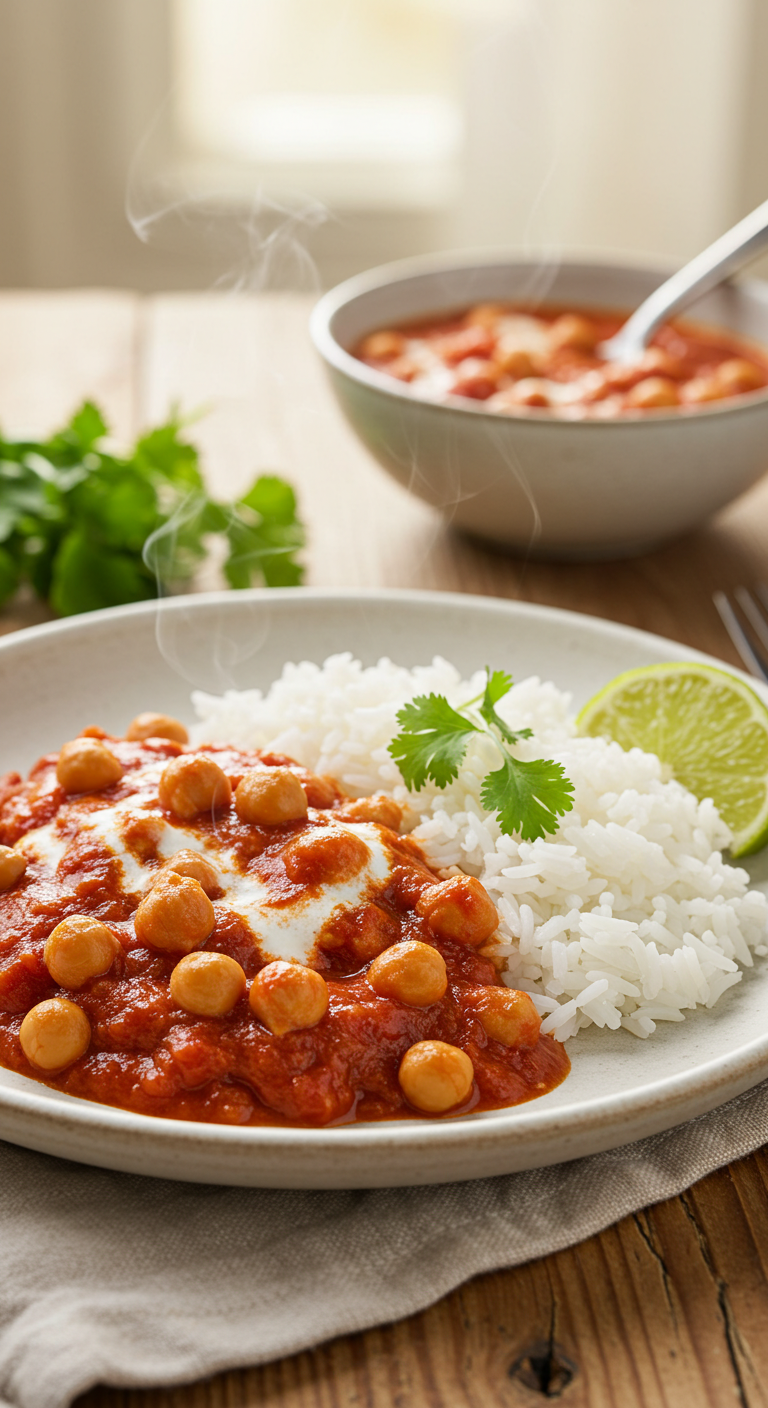Ever had one of those nights where you just need something that hugs you from the inside out? Something warm, silky, fragrant — but also dead simple to throw together? That’s this Creamy & Cozy Chickpea & Tomato Coconut Curry. It’s like a soft blanket in a bowl — with a touch of spice, a whisper of coconut, and that magical balance of comfort and vibrance that only curry can pull off.
It’s vegan, naturally gluten-free, and somehow tastes even better the next day (hello, meal prep hero). The kind of dish that makes you forget takeout even exists. Let’s dive in.
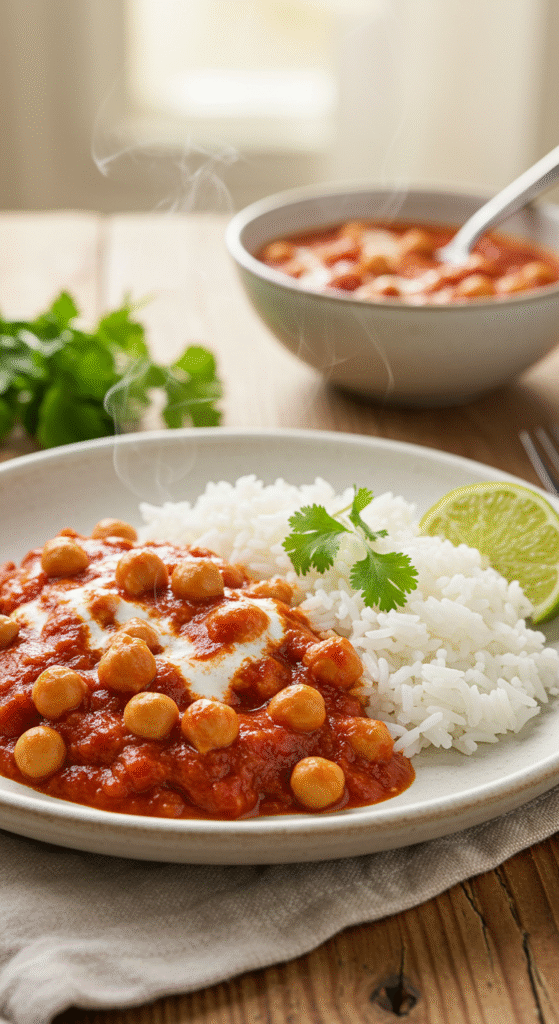
Why This Curry Is Special
You can find chickpea curries in kitchens from India to the Caribbean to coastal Thailand — each one unique, each one rich in tradition. But this version? It’s a little mash-up of all those influences. Creamy coconut milk gives it that lush, tropical body. Crushed tomatoes bring bright acidity. Toasted spices and aromatics layer in that deep, soulful flavor you can’t quite define but always crave again.
It’s also a weeknight savior. You can make it in one pot, no fancy ingredients, and it’s incredibly forgiving. Forgot to soak beans? Canned chickpeas. No fresh ginger? Ground will do. The base is so flavorful that it forgives nearly any shortcut.
The other thing — and chefs don’t say this lightly — is balance. This curry sings because every element has a voice: heat from chili, tang from tomato, richness from coconut, earthiness from chickpeas. You don’t just eat it; you feel it.
Ingredients & Substitutions

Let’s break down what makes this curry tick — and what to do if your pantry plays hard to get.
Chickpeas – The sturdy heart of the dish. Canned chickpeas are totally fine (drained and rinsed), but if you have time, cooking dried chickpeas from scratch brings a deeper, nuttier flavor. If you’re out of chickpeas, try lentils or white beans.
Coconut Milk – This is where the creaminess comes from. Use full-fat coconut milk for that luscious texture and body. Light coconut milk will work, but it’ll be thinner and less rich. Coconut cream? Go for it if you want ultra-silky decadence.
Tomatoes – Crushed canned tomatoes are the easiest. Fresh tomatoes work too if they’re ripe and juicy — just cook them down longer. Tomato paste adds a deep base note, so don’t skip it if you have some.
Onion, Garlic, Ginger – The aromatic trio that builds the flavor foundation. Fresh is best, but pre-minced garlic or frozen ginger can pinch-hit in a rush.
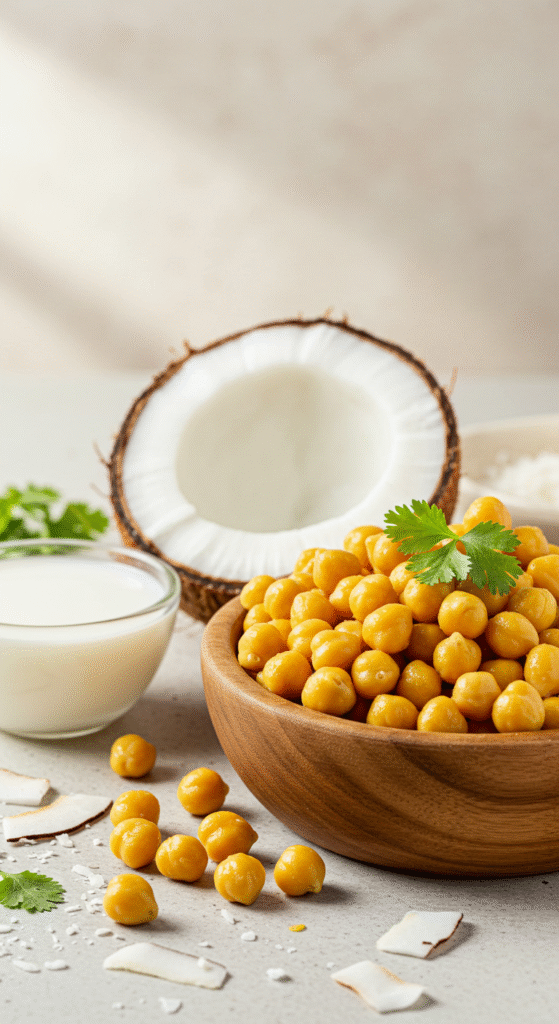
Spices – Here’s the flavor symphony:
- Cumin – Earthy warmth.
- Coriander – Citrusy brightness.
- Turmeric – Golden color, subtle bitterness.
- Garam Masala – That complex, fragrant finish.
- Chili flakes or powder – Heat to taste.
You can easily play around. Add smoked paprika for depth, or curry powder if that’s what’s on hand.
Vegetable Broth – Helps loosen the curry and infuse more flavor. Water works too — just season a touch more.
Lime Juice & Fresh Cilantro – Don’t skip these at the end. Acid and herbs bring everything to life.
Oil – Neutral oil works best (canola, sunflower, or coconut oil for extra aroma).
Pro Tips:
- Always toast your spices briefly in oil before adding liquid. It wakes them up.
- Taste as you go. Salt, acid, and heat make or break curry flavor.
- If you love texture, toss in a handful of spinach or kale near the end — it wilts beautifully.
Step-by-Step Instructions
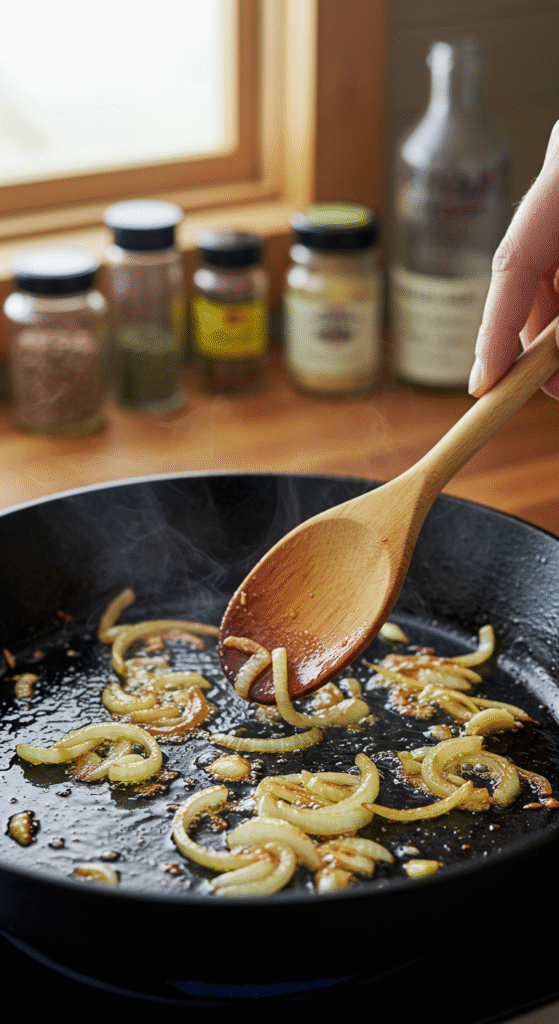
Think of curry as an exercise in patience and layering. Nothing hard, just a little rhythm.
Step 1: Sauté the Aromatics
Start by heating oil in a large pot or deep skillet. Add finely chopped onion and cook until golden brown — about 8 minutes. Don’t rush this; caramelizing the onions builds the base flavor.
Add minced garlic and ginger. Stir for 30 seconds, just until fragrant.
Step 2: Bloom the Spices
Now toss in your cumin, coriander, turmeric, and chili. Stir constantly for about 30 seconds. You’ll smell the difference — this blooming step is what turns dull spice into full-blown aroma.
Step 3: Build the Sauce
Add tomato paste and stir until it darkens slightly (a minute or two). Then pour in crushed tomatoes and a splash of broth. Let it simmer gently for 5 minutes. The mixture should thicken and start looking jammy.
Step 4: Add the Chickpeas and Coconut Milk
Stir in the chickpeas, followed by coconut milk and the rest of your broth. Mix well, scraping the bottom of the pot.
Step 5: Simmer
Bring to a gentle boil, then lower the heat and simmer uncovered for 15–20 minutes. The sauce should reduce and thicken into a creamy, dreamy consistency. Stir occasionally so it doesn’t stick.
Step 6: Taste and Adjust
Add salt, a squeeze of lime, and chopped cilantro. Taste again — you might want a touch more acid or spice.
Variations
- Extra Spicy: Add a diced jalapeño or a spoonful of chili paste.
- Creamier: Stir in extra coconut cream or a spoonful of cashew butter.
- Veggie Boost: Add diced sweet potato or cauliflower with the chickpeas.
- Protein Twist: Toss in cubed tofu or paneer if you’re feeling fancy.
Mistakes to Avoid
- Don’t skip the onion stage. Undercooked onions make the base too sharp.
- Don’t boil coconut milk too aggressively — it can split.
- Taste often. Curries evolve as they cook.
Cooking Techniques & Science

Here’s the fun part: why all these steps matter.
When you sauté onions slowly, you’re triggering the Maillard reaction — the same browning that gives grilled meat or toasted bread their irresistible flavor. The sugars and amino acids in onions transform, adding sweetness and depth to the curry.
Blooming spices in hot oil? That’s fat-soluble flavor extraction. Spices release their essential oils only when heated in fat, so skipping that step dulls everything.
Simmering gently with coconut milk lets water evaporate and concentrates the flavors without curdling the fat. It’s controlled reduction — you’re coaxing the ingredients into harmony rather than rushing them.
Tools matter, too. A heavy-bottomed pot (like cast iron or enamel) distributes heat evenly and prevents scorching. Wooden spoon? Always. It helps you feel the sauce thickening.
Curry is as much about intuition as precision. You’ll learn to trust the smell, the texture, the color. It’ll tell you when it’s ready.
👉 Recipe Card
Creamy & Cozy Chickpea & Tomato Coconut Curry
Servings: 4
Prep Time: 10 mins
Cook Time: 30 mins
Total Time: 40 mins
Ingredients
- 2 tbsp oil (neutral or coconut)
- 1 medium onion, finely chopped
- 3 cloves garlic, minced
- 1 tbsp grated ginger
- 1 tsp cumin
- 1 tsp coriander
- ½ tsp turmeric
- 1 tsp garam masala
- ½ tsp chili flakes (adjust to taste)
- 1 tbsp tomato paste
- 1 can (14 oz) crushed tomatoes
- 1 can (15 oz) chickpeas, drained and rinsed
- 1 can (14 oz) full-fat coconut milk
- ½ cup vegetable broth
- Salt to taste
- Juice of ½ lime
- Fresh cilantro, chopped
Instructions
- Heat oil in a large pan over medium heat. Add onion and cook until golden, 8 minutes.
- Add garlic and ginger; sauté 30 seconds.
- Stir in all spices and bloom 30 seconds.
- Add tomato paste and cook 1–2 minutes until darkened.
- Pour in crushed tomatoes and half the broth. Simmer 5 minutes.
- Add chickpeas, coconut milk, and remaining broth. Stir and bring to a gentle simmer.
- Cook 15–20 minutes until thickened and creamy.
- Season with salt, lime juice, and cilantro.
Nutrition (per serving):
Calories: ~340 | Protein: 10g | Fat: 22g | Carbs: 30g | Fiber: 8g
Serving & Pairing Suggestions
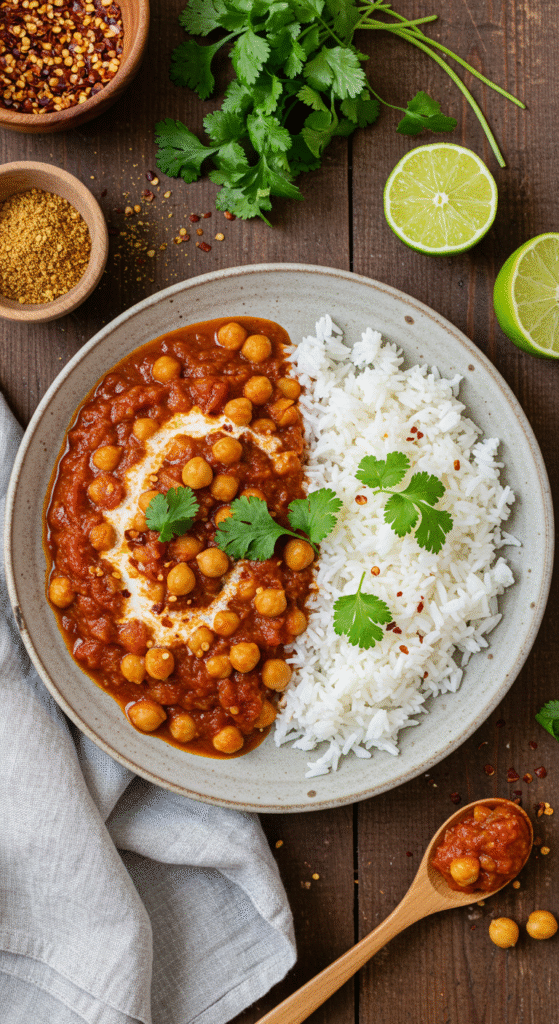
Now, how do you serve this masterpiece?
Spoon it generously over fluffy basmati rice or steamed jasmine rice — something light to soak up that sauce. Or go hearty with garlic naan or roti, perfect for scooping every drop.
Want to fancy it up? Top with a drizzle of coconut cream and a scatter of fresh herbs or sliced chili. For crunch, sprinkle toasted cashews or seeds on top.
Drink-wise, a crisp lager or a lightly sweet Riesling balances the spice beautifully. For a non-alcoholic pairing, coconut water or a mango lassi cools things down nicely.
If you’re meal-prepping, pack it with a side of quinoa or brown rice. It holds up like a champ and tastes even better after a day in the fridge.
Conclusion
There’s something magical about this dish. It’s humble ingredients — chickpeas, tomatoes, coconut milk — but together, they create something greater than the sum of their parts. Creamy, cozy, and layered with warmth.
The best part? Once you’ve made it once, you’ll start riffing. Maybe add roasted vegetables next time, or swirl in spinach, or turn it into soup with extra broth. Curry is a canvas, and you’re the artist.
So grab a pot, trust your senses, and let that comforting aroma fill your kitchen. You’ll know when it’s ready — it’ll smell like home.
FAQs
1. Can I freeze chickpea and tomato coconut curry?
Absolutely. It freezes beautifully for up to 3 months. Let it cool completely before sealing in airtight containers. Reheat gently on the stove, adding a splash of broth or coconut milk to loosen.
2. Can I use light coconut milk to make it healthier?
Yes, but the texture will be lighter and less creamy. A trick: add a spoonful of cashew butter or blended soaked cashews for creaminess without extra fat.
3. What can I serve instead of rice?
Quinoa, couscous, or even roasted cauliflower rice. Flatbreads like naan or pita work great too.
4. How do I make it spicier?
Add diced fresh chili, a spoonful of curry paste, or extra chili flakes. Bloom them early in the oil to release more heat.
5. Can I make it ahead?
Totally. In fact, it improves overnight as the flavors mingle. Just store in the fridge and reheat gently — maybe add a squeeze of lime before serving to freshen it up.
This Creamy & Cozy Chickpea & Tomato Coconut Curry isn’t just a recipe — it’s a keeper. A bowl of comfort, flavor, and ease you’ll come back to whenever you need warmth in your week.
Would you like me to add Pinterest descriptions + image prompts for this recipe (for SEO/blog use)?

Selena is an experienced lifestyle blogger and the voice behind many of Cozy Toned’s inspiring posts. With a passion for mindful living, home styling, and everyday wellness, she shares practical tips and fresh ideas to help readers live beautifully and intentionally.
